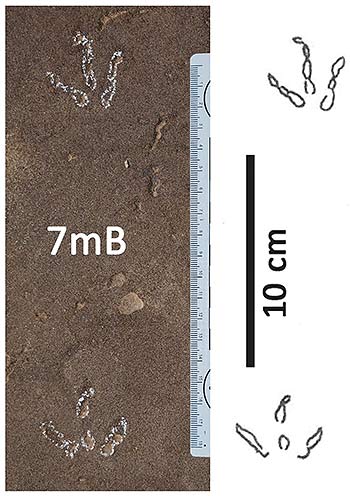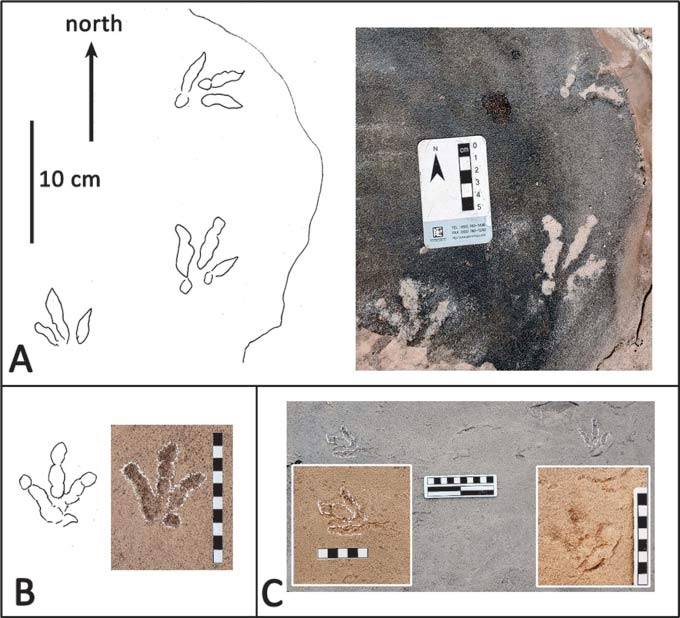 |
| These small tracks are undeniably “cute” and no bigger than those of small birds like today’s sandpipers or plovers. This just proves that small dinosaurs were abundant in the Jurassic, even if their bones are very rare, and their recently discovered tracks have been overlooked. 7mB refers to the site location. |
The late Fran Barnes, resident of Moab, was a tireless explorer. As a result, he found many tracksites, dozens in fact, within a small radius of Moab. He once wrote me a letter stating:
“you may have notice that I outlined the problem of the myriad theropod tracks in the top of the Moab-Entrada”
As outlined in last month’s contribution, this hardly “a problem” for the keen tracker. Rather it is an “embarrassment of riches” telling us just how abundant trackmakers were in the Jurassic, the time period Barnes was talking about. Also, in last month’s contribution I mentioned the sites, with big tracks, that are easy to find like Willow Springs, the Stomping Ground tracksite, or the Bull Canyon site. These all occur at the same geologic level and make up to Moab Megatracksite. They have also been made into destinations by the BLM and USDA Forest Service, and feature interpretative signs. All three sites reveal numerous large three toed theropods tracks. One of the “problems” Fran Barnes ran into in the 1970s and 1980s when he started tracking, is that he could not get professional paleontologist to come out and look at tracks. He even mentioned this ‘gripe’ in some of the many guidebooks he self-published right in Moab. This is perhaps not surprising as most dinosaur paleontologists were, at that time, only interested in the abundant bones found in and around the Dinosaur Diamond since the early 1900s. But things began to change in the 1980s, especially when the Moab Megatracksite was discovered. Suddenly tracks were interesting because they could be used to interpret the dynamic behavior of once-living dinosaurs. Some have said they are like movies of dinosaurs.
But to give Barnes full credit, he found a “myriad” of other tracks of different types, and it is only now that they are being seriously studied. These small three-toed tracks, are “very cute” and only 1 to 3 inches long, so the trackmakers were bird-sized. Small, feathered dinosaurs appear round the world at this time. Small dinosaurs only appear rare because their bones are fragile and easily lost before they become fossilized.
These small tracks, rather than being found on what was once the megatracksite shoreline, where large tracks are so abundant, occur instead just below this level, in what geologists know were sand dunes, slightly inland from the ancient shoreline. However, in the right light and with careful exploration our tracker team has found at least 40 sites. Because they are so small, they are shallow and easy to miss. There are no large tracks at this small tracks level, perhaps because food was limited in the dunes. So, Barnes was right to refer to myriad sites. He was also right that trackers had overlooked or paid no attention to these tracks.
The moral of this story is that very “cute” and interesting tracks are out there to be found, potentially in large numbers, or ‘myriads.’ Our tracker teams has relied on people like Barnes and Lyn Ottinger, of Rock Shop fame, to find many tracks that were later described scientifically. See the slab outside the BLM office. This tradition continues as Moab residents continue to find “cool” and “cute” tracks and share their finds with the professional paleontological community. Our motto is to “keep on trackin.”
 |
| A,B and C represent three sites with “cute” small or baby tracks found in 2022. Being only about 1-2 inches (3-6 cms) long they have mostly been overlooked by professional paleontologists. |
|